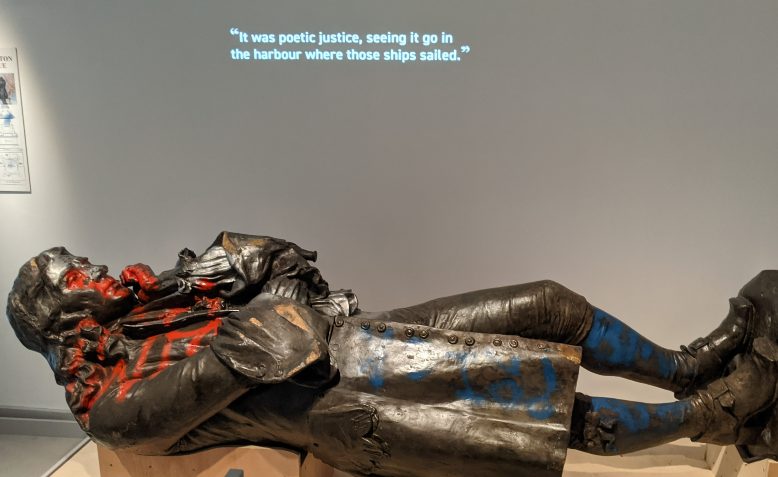 Colston Statue in the M Shed museum. Photo: ian262 / Flickr / CC BY-NC-ND 2.0. license linked at bottom of article
Colston Statue in the M Shed museum. Photo: ian262 / Flickr / CC BY-NC-ND 2.0. license linked at bottom of article
The courageous protesters that took down the statue of slave trader Colston should not be the ones on trial, argues Simon Duckett and James Griffiths
The trial has begun in Bristol of the four people, Rhian Graham, 29, Milo Ponsford, 25, Jake Skuse, 36, and Sage Willoughby, 21, accused of taking down the statue of the slave trader Edward Colston from his plinth and rolling it into the harbour during a large Black Lives Matter demonstration.
The demonstration took place on 7 June last year in response to the murder of George Floyd by police in the United States. Repeated requests over many years had been made to Bristol City Council to remove the statue, or at the very least instigate a debate about its future, to no avail. Finally, after years of stonewalling and equivocation by the Council, people took the matter into their own hands.
The four are putting up a spirited and unapologetic defence of their actions, supported by a grassroots campaign. Professor David Olusoga has been called as a defence witness, Bristol artist Banksy has designed t-shirts and local musicians have put on a night to raise money for the defendants.
Colston the slave trader
That Colston was centrally involved in the barbaric trading of human beings as chattels is not denied, even by the ‘you can’t change history’ brigade. He was a member of the Royal African Company which held a monopoly on the English trade in African slaves.
It’s estimated that the company transported over 84,000 African men, women and children to the Caribbean, of whom as many as 19,000 may have died on the journey. Human beings who were kidnapped from their homes, many as children separated from their families, and forced onto vessels to sail thousands of miles away in appalling conditions to be forced to work on pain of death or mutilation. Many died in transit of disease when they were simply thrown overboard, (commemorated by the dumping of the statue in the harbour) many whilst still alive, so that the slavers could claim on their insurance for loss of ‘goods’.
Years later, when slavery was finally abolished, these slavers would be compensated for their ‘loss’. Compensation amounting to £20,000,000 was paid to former slave owners (equivalent to £16 billion today), a sum so large that the final sums were not paid until 2015. Former slaves, of course, got nothing. More people in Bristol were compensated than any other city in Britain other than London.
Much is made by Colston’s supporters of his contribution to Bristol life and how the ‘people of Bristol’ benefited from his generosity. Of course, even a cursory glance at the conditions of ordinary people in Bristol at the time will show that a large majority lived in slum conditions infested with disease and completely unable to access the elite institutions built to benefit the families growing rich on the proceeds of the ‘triangular trade’. In fact, these institutions themselves are dropping his name as belated recognition that it is hugely inappropriate for institutions of learning and culture to be celebrating such an individual. Indeed, the toppling of the statue in Bristol reverberated around the world inspiring others to cast their own local representatives of barbarity to the ground.
His statue now lies on display in the M Shed, a Bristol dockside museum, where it should have been put a long time ago. Long may it stay there as a historical artefact reminding us not only that the desire for vast profits at all costs amongst the few is, for them, worth pursuing even at the cost of unimaginable human suffering, but also of the courageous defiance that took him off the plinth in a moment of collective resistance.
After all, we can’t change history, but we can change the present.
Donate to the defence fund here
Before you go
Counterfire is growing faster than ever before
We need to raise £20,000 as we are having to expand operations. We are moving to a bigger, better central office, upping our print run and distribution, buying a new printer, new computers and employing more staff.

